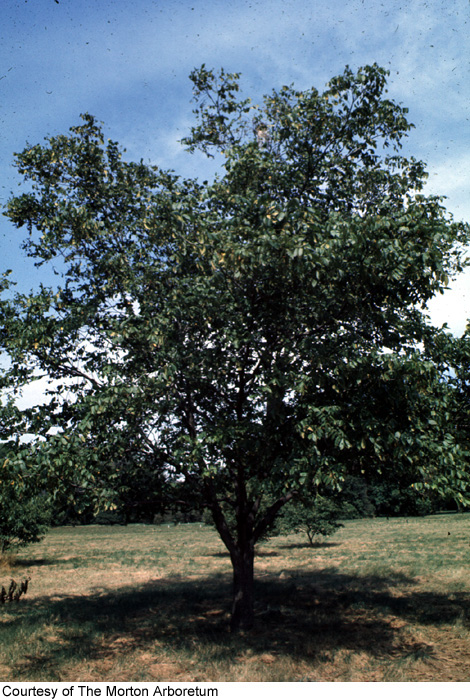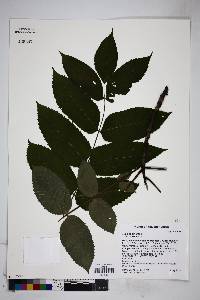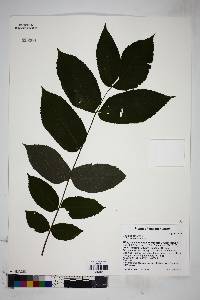|
|
|
|
Family: Juglandaceae
butternut
[Wallia cinerea (L.) Alef.] |
Trees , to 20(-30) m. Bark light gray or gray-brown, shallowly divided into smooth or scaly plates. Twigs with distal edge of leaf scar straight or nearly so, bordered by well-defined, tan-gray, velvety ridge; pith dark brown. Terminal buds conic, flattened, 12-18 mm. Leaves 30-60 cm; petiole 3.5-12 cm. Leaflets (7-)11-17, ovate to lanceolate or oblong-lanceolate, ± symmetric, (2.5-)5-11(-17.5) × 1.5-6.5 cm, margins serrate, apex acuminate; surfaces abaxially with abundant 4-8-rayed fasciculate hairs, scales, and sometimes capitate-glandular hairs, axils of proximal veins with prominent tufts of fasciculate hairs, adaxially with scattered fasciculate hairs or becoming glabrescent; terminal leaflet present, usually large. Staminate catkins 6-14 cm; stamens 7-15 per flower; pollen sacs 0.8-1.2 mm. Fruits 3-5, ellipsoid to ovoid or cylindric, 4-8 cm, smooth, with dense capitate-glandular hairs; nuts ellipsoid to subcylindric or ovoid, 3-6 cm, surface with ca. 8 high, narrow, longitudinal main ridges, with narrow, interrupted, longitudinal ridges or lamellae between main ridges. Flowering spring (Apr-Jun). Rich woods of river terraces and valleys, also dry rocky slopes; of conservation concern; 0-1000 m; N.B., Ont., Que.; Ala., Ark., Conn., Del., Ga., Ill., Ind., Iowa, Ky., Maine, Md., Mass., Mich., Minn., Miss., Mo., N.H., N.J., N.Y., N.C., Ohio, Pa., R.I., S.C., Tenn., Vt., Va., W.Va., Wis. The butternut canker is killing Juglans cinerea across its range. Because the trees do not root-sprout, the range is contracting.
Tree to 20 m tall, trunk 30 cm - 0.6 m in diameter Leaves: alternate, pinnately compound, 25 - 50 cm long, with eleven to seventeen leaflets. Flowers: either male or female, found on the same plants (monoecious), male flowers clustered in hanging catkins 6 - 14 cm long, female flowers (8 mm long) solitary or few on a stalk. Fruit: a nut surrounded by a husk, 4 - 8 cm long, 3 cm wide, solitary or in small clusters. The husk is green, lemon-shaped, and sticky-haired. Nuts enclosed by a 3 - 6 cm long, ridged, two-celled shell. Bark: light gray and smooth, developing smooth ridges and shallow plates, inner bark turning yellow when exposed. Twigs: stout, orangish brown to green with rust-colored hairs when young, becoming light gray and smooth. The center of the twig (pith) is divided into dark brown chambers. Terminal buds: brown, 1.2 - 2 cm long, oblong to conical, flattened, hairy. Leaflets: short-stalked with stalk of terminal leaflet longest, yellowish green above, pale beneath, 5 - 11 cm long, 1.5 - 6.5 cm wide, egg-shaped to narrow oblong, finely toothed, rough-haired above and soft-haired beneath. Foliage smells like fresh hay or paint when crushed. Lateral buds: small and egg-shaped. Leaf scar: resembling a monkey's face, with a line of tannish gray velvety hairs along the top margin and three U-shaped vascular bundle scars. Similar species: The similar Juglans nigra usually lacks a terminal leaflet, has spherical fruit, dark brown to grayish black bark, cream-colored pith, a short terminal bud, and the leaf scar is deeply notched at the top and lacks hair on the upper margin. Flowering: late April to mid May Habitat and ecology: Mesic woods, moist river slopes, bluff savannas, wooded floodplains and calcareous slopes with springs. Occurence in the Chicago region: native Notes: Juglans cinerea wood is used to make furniture, cabinets, and interior trim. An orange-yellow dye was once removed from the husk and inner bark to dye clothing. A sweet syrup can be produced from the sap. Etymology: Juglans comes from the Latin name for walnut, which is derived from the words jovis, meaning "of Jupiter," and glans, meaning acorn. Cinerea comes from the Latin word meaning ash-colored, referring to the bark. Author: The Morton Arboretum Tree to 30 m; bark grayish-brown, with smooth ridges; pith dark brown; a dense pad of short hairs often present long the upper margin of old lf-scars; lfls 11-17, oblong-lanceolate, acuminate; pubescence, especially of the lower lf-surface, largely or wholly of stellate, few-rayed hairs; fr ovoid- oblong, 4-7 cm, somewhat pointed; nut ovoid to short-cylindric, longer than thick, very rough, marked with 2 or4 obscure longitudinal ridges. Rich, moist soil; N.B. to Minn., s. to S.C., Ga., and Ark. (Wallia c.) Gleason, Henry A. & Cronquist, Arthur J. 1991. Manual of vascular plants of northeastern United States and adjacent Canada. lxxv + 910 pp. ©The New York Botanical Garden. All rights reserved. Used by permission. |




